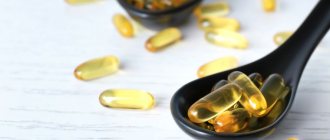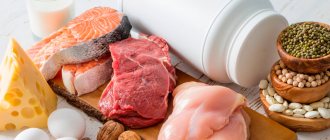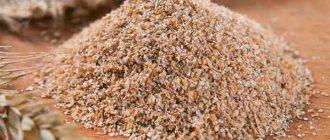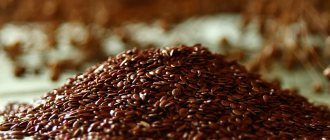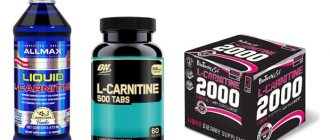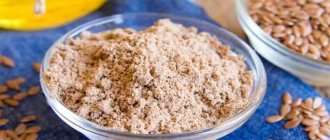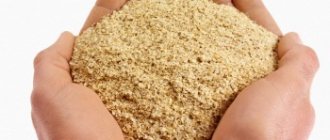Linoleic acid, which belongs to the Omega 6 group of polyunsaturated acids and is a component of vitamin F, is very important for our body. It is involved in metabolism, reduces the risk of cardiovascular diseases, stops the growth of cancer cells, improves immunity and is involved in the process of hematopoiesis.
Linoleic acid in cosmetology restores turgor and reduces skin dryness, which leads to rapid cell regeneration and overall rejuvenation. But an excess of LA can provoke obesity, diabetes and heart attack. Let's analyze in detail - linoleic acid benefits and harms for the body, what products you can get it with and what cosmetics to use to support youthful facial skin.
Why do women need linoleic acid?
Linoleic acid, unlike folic acid, is not called “female acid,” but its deficiency or, conversely, excess in the body primarily “hits” the regenerative system. The proper functioning of the ovaries and thyroid gland is reduced due to the ineffective functioning of the circulatory system.
LA is responsible for all processes in the cerebral cortex; its deficiency provokes sclerosis and stroke. The group of polyunsaturated fatty acids Omega 6 includes more than 10 components, but these acids work correctly only if there is a sufficient amount of another group of Omega 3 acids in the body. Roughly speaking, for a woman’s body to work correctly, it is necessary to maintain a balance of Omega 6 and Omega 3. The first should be 3-5 times more.
Benefits of linoleic acid
Linoleic acid is responsible for the following processes in the body:
- makes blood vessels dense and elastic;
- relieves inflammation;
- reduces cholesterol levels and prevents its accumulation;
- stabilizes the immune system;
- participates in the production of the correct amount of hormones (included in all processes of the human endocrine system);
- enhances cell regeneration;
- regulates a woman's hormonal levels.
Unlike acids of the Omega 3 group, Omega 6 is found in many products, especially in vegetable oils. When choosing oil, it is necessary to control the amount that comes with food. Oversaturation of the body threatens big troubles.
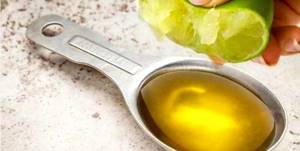
Benefits and harms of the substance
CLA has a number of beneficial properties. But, like any other supplement, if the instructions are not followed, it can cause harm. This natural substance has a powerful anticarcinogenic and antioxidant effect. In general, it has a beneficial effect on the digestive system, takes an active part in the synthesis of fats and proteins, and allows you to speed up metabolism, which is very important for losing weight. Conjugated linoleic acid is extremely necessary for the body, as it has a stimulating effect on the immune system, and, as a result, reduces the risk of acute viral diseases.

The substance actively fights fat formed on internal organs, promoting the growth of lean muscle mass, improves the condition of nails, hair and skin, ensures the proper functioning of the cardiovascular and neuroendocrine systems, actively participating in the synthesis of prostaglandins. Supports the reproductive system.
Despite the fact that omega-6 is a substance that has only positive properties, it can also have negative effects. R. Brown in 2009 conducted a series of clinical studies and described that abuse of this substance will inevitably lead to the development of pathologies such as stroke, heart attack and even cancer.
The harm of linoleic acid to our body is stop fat!
The following symptoms may indicate that you are not getting enough linoleic acid:
- disruptions of the monthly cycle;
- fast fatiguability. Constant weakness;
- dry, flaky skin, brittle nails;
- frequent colds;
- swelling on the face (without irritating factors);
- joint diseases.
All these symptoms indicate that the body is experiencing a delay in metabolism and a weakened cardiovascular system.
Oversaturation also threatens us with dangerous consequences. You can even say that if the deficiency of linoleic acid is replenished - it is enough to reconsider the diet, then an excess can provoke serious diseases that will be very difficult to cure with diet. What are the dangers of permanent overdose:
- obesity;
- against the background of obesity, heart attacks become more frequent;
- thrombosis;
- heart diseases;
- Constant irritability appears, mental breakdowns may occur, and neurasthenia develops.
Since linoleic acid in most cases enters the body with vegetable oils, it is necessary to limit their consumption. The leaders in the amount of linoleic acid remain sunflower and corn.
But olive oil has a balanced composition of Omega 3 and Omega 6, so get into the habit of using olive oil for salads and baked goods.
Mechanism of weight loss
Recently, experts are increasingly questioning whether linoleic acid is effective for weight loss.
Yes, studies have confirmed that it is an invariable participant in many processes in the body that ultimately lead to weight loss. For example:
- prevents the conversion of energy into fat deposits;
- accelerates many metabolic processes, including lipolysis;
- helps build muscle mass subject to constant physical activity;
- helps with “drying” the body;
- reduces the amount of insulin released;
- corrects the figure by burning fat;
- reduces volume in the waist (primarily) and hips, but only if you follow a low-calorie diet;
- prevents future weight gain;
- normalizes the level of triglycerides and cholesterol in the blood.
However, all this manifests itself in very small quantities. You often have to wait up to 2-3 months for visible results, and sometimes longer. In this regard, the same protein works much faster.
And yet, if the body lacks linoleic acid, if there are problems with the cardiovascular system and if sport is your second self, you can try to lose weight with the help of this unique dietary supplement. Moreover, there is no shortage of it in the modern sports nutrition market. And as a bonus, you will receive a strengthened immune system, a reduced risk of cancer, and an antioxidant effect.
Additional Information. The following symptoms indicate a deficiency of CLA in the body: fatigue, swelling (mainly on the legs and face), weakness, dry skin, dandruff, decreased immunity, menstrual cycle failure, peeling on the knees and elbows, peeling nails, memory impairment, decreased concentration, joint pain, bone fragility, infertility, problems with the cardiovascular system.
Vegetable oils are leaders in linoleic acid content
Sunflower . In 100 gr. oil contains up to 70 grams of LA. At the same time, there are no other Omega 3 and Omega 9 acids necessary for the balance in sunflower oil. Doctors recommend consuming no more than 2 tablespoons per adult.
Corn . Corn oil contains the highest amount of vitamin E (when compared with other vegetable oils). Linoleic up to 60%. Corn oil has antioxidant properties, reduces inflammation and strengthens the immune system. Recommended for dietary purposes. The average norm for an adult is 10-15 grams. per day.
Soy . Despite the numerous beneficial properties of soybean oil, we do not recommend it for food, but only as a component for anti-aging masks.
Cotton . Oil is practically not eaten in European and CIS countries, but the product is very popular in America and Asia. Linoleic content is 55%, the oil is very easily absorbed, the recommended dose is 10 g.
Linen . The oil has a balanced composition of Omega 3 and 6, ideal for salad dressings and as a component for cosmetic masks. Here it is important to buy high-quality and fresh linseed oil, which has a limited shelf life and is demanding in terms of storage conditions. Find out all the benefits of flaxseed oil for women here...
Linoleic acid and linolenic acid - what is the difference?
The grammatical similarity in the sound of the names of these acids has led to the fact that linoleic and linolenic are often confused, but these are completely different types of acids. Linoleic acid belongs to the Omega 6 class, linolenic acid to the Omega 3 class. The acids complement each other and are necessary for the body to function properly.
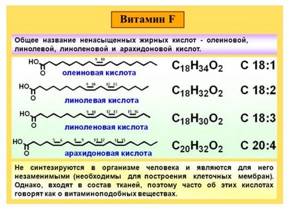
Significance in the body

It is necessary for the normal functioning of the body as a whole. Animals, in the process of eating grass, obtain from it omega-6 fatty acids, which were discussed above. The animal’s body has a unique enzyme that can convert them into linoleic acid. Thus, the process of its “production” is 100% natural.
Further, the acid accumulates in the fat of meat and milk of animals, which in turn are consumed by humans. Mainly phosphatides and triglycerides enter his body.
- It is from this substance that arachidonic fatty acid is synthesized, which is essential for some other animals, for example, cats. Cellular and subcellular membranes contained in the human body consume the most conjugated substance.
- A large amount of linoleic acid is found in vegetable oils and fats of natural origin. Approximately 50% of their composition is often occupied by triglycerides. We are talking about oils based on flax, hemp, sunflowers and cotton.
Conjugated linoleic acid - what is it and how does it help with weight loss
The chemical formula of LA consists of several double bonds; there can be a total of 26 in the structure. If double transitions are present in the molecular bond, the element is considered an isotope. Two isotopes of linoleic acid have the greatest value for the body, one of them received the trade name - conjugated linoleic acid.
It is conjugated linoleic acid that is used in dietary supplements for weight loss and for building muscle mass. Acid effectively reduces adipose tissue and has a beneficial effect on the body as a whole. The best dietary supplements with linoleic acid, how and how much to take, see here...
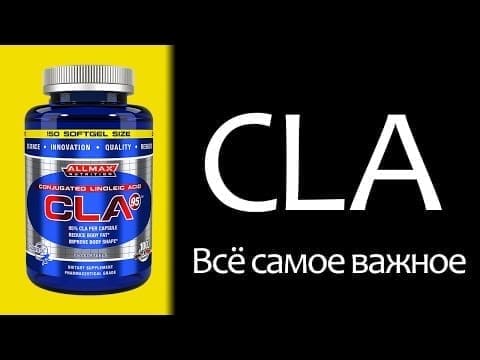
CLA is capable of taking water away from the body's cells.
What you will typically see in natural (non-steroid-using) bodybuilders is that when they take excessive doses, they develop dehydration and cramps in the legs and other muscle groups.
From this point of view, conjugated linoleic acid supplements act as a weak diuretic (diuretic).
Another well-known sign that you're not drinking enough water is dizziness. This is especially noticeable when doing heavy squats, which require a huge amount of energy. Dehydration leads to dizziness. Although this can be easily corrected by drinking more water, it is still one of the side effects that you need to be aware of.
Additionally, some studies have shown that CLA may increase insulin resistance. This in itself is not necessarily a bad thing, because omega-3, fish oil, and vitamin C, for example, can increase insulin resistance. And we all know that these substances are good for health.
However, you need to know about this too. And people who have diabetes should consult a doctor before taking this dietary supplement. In fact, anyone planning to take it for the first time should consult a qualified professional.
More about sports nutrition: creatine for gaining muscle mass.
Linoleic acid in cosmetology
The ability of LA to enhance cell regeneration and retain moisture contributes to the fact that creams with linoleic acid have a rapid rejuvenating effect. Another property of the acid is that it does not disintegrate under the influence of oxygen and penetrates well into the middle layers of the skin, which allows you to restore turgor.
Cosmetics are often designed for aging, aging-prone facial skin. The correct ratio of acid, vitamins and binding components makes face creams so effective.
Linoleic acid, like retinol, is often added to serums. It is important to remember that serum, unlike cream, is rarely used; 1-2 complexes per year are enough.
Cosmetic oils
Cosmetic oils with a high concentration of linoleic acid can be safely used as masks, tonics and lotions. Your personal oil tolerance plays a major role here. Triglycerides of fatty acids have the following effects on our skin.
- Heal wounds, cracks, accelerate tissue regeneration.
- Retains moisture in the skin.
- Strengthen blood vessels, reduce the risk of rosacea, eliminate its manifestations.
- Accelerates natural collagen synthesis.
Linoleic acid has a beneficial effect on any skin type, but mature ladies value it more - it is what restores the skin and restores youth. Which oils are rich in this plant miracle:
- grape seeds;
- safflower;
- watermelon;
- wheat sprouts.
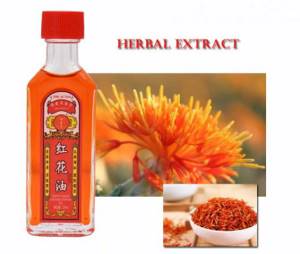
Buy SAFFLOR OIL right now from the manufacturer
